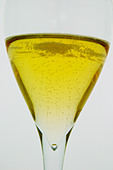South Africa, part 6: MCC and bubbles!
>> Monday, July 12, 2010
 We were very impressed by some of the MCCs that we tasted in South Africa. Behind this code (that you have to learn if you go tasting in SA) hides Method Cap Classic, meaning the “traditional” way of making sparkling wine with a second fermentation in the bottle. The MCC that Teddy Hall makes is complex and full of character, with four years on the lees (before degorgement). It has a toasty character that comes from the long aging. David Niekerk at High Constantia makes exceptional MCC in the Constantia region, with three years on the lees. The grapes come from high altitude vineyards and the bunches are pressed whole. “I only get 400 litres from 1000 kg”, he explains (in Champagne the extract around 630 l per 100 kg). The wine is dust-dry since he makes no dosage (adding of sugar). It has only 0.6 g of natural residual sugar.
We were very impressed by some of the MCCs that we tasted in South Africa. Behind this code (that you have to learn if you go tasting in SA) hides Method Cap Classic, meaning the “traditional” way of making sparkling wine with a second fermentation in the bottle. The MCC that Teddy Hall makes is complex and full of character, with four years on the lees (before degorgement). It has a toasty character that comes from the long aging. David Niekerk at High Constantia makes exceptional MCC in the Constantia region, with three years on the lees. The grapes come from high altitude vineyards and the bunches are pressed whole. “I only get 400 litres from 1000 kg”, he explains (in Champagne the extract around 630 l per 100 kg). The wine is dust-dry since he makes no dosage (adding of sugar). It has only 0.6 g of natural residual sugar.
At Anura, at the foot of Simonsberg, between Stellenbosch and Paarl, winemaker Johnnie Calitz applies the philosophy of not interfering much at all, “don’t mess too much with the wine…” he says. It’s a philosophy that generates excellent results. His MCC Brut with 40% pinot noir and 60% chardonnay (ZAR 180) has neither been treated with sulphur nor given any dosage, and it’s very good. Johnnie likes to experiment and he has been testing different yeast strains to see what difference it makes and to see the difference between “cultured” yeasts and “natural” yeast. Using different types of yeast strains gives added complexity to the wine he says.
Have you tried MCC?









0 comments:
Post a Comment